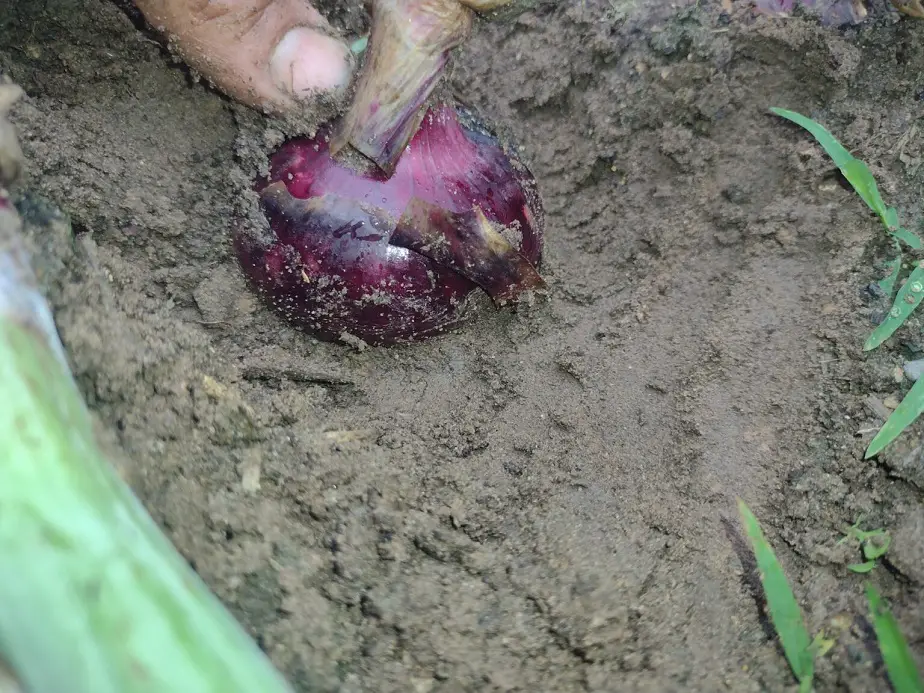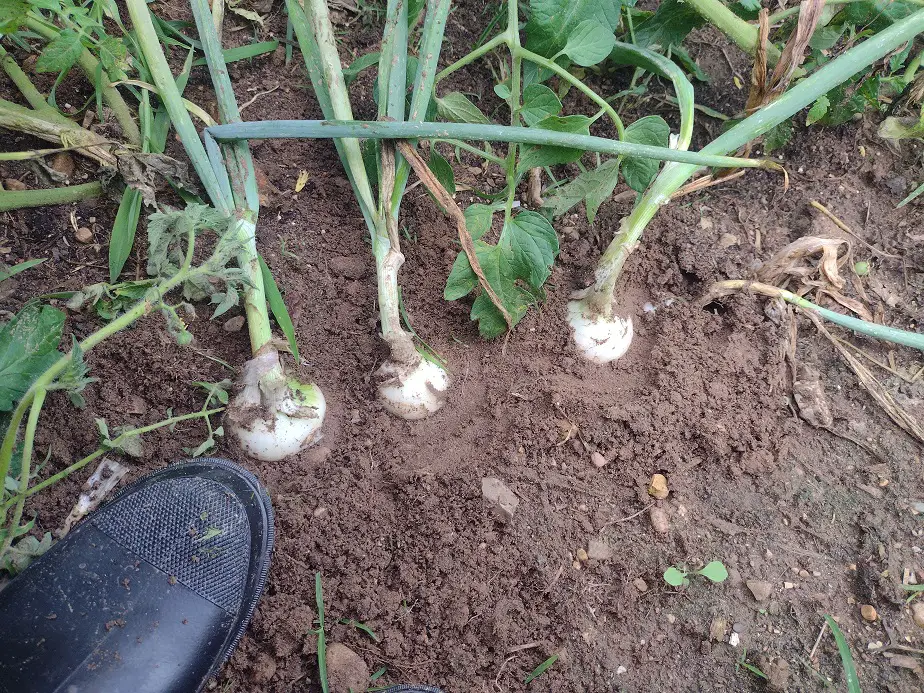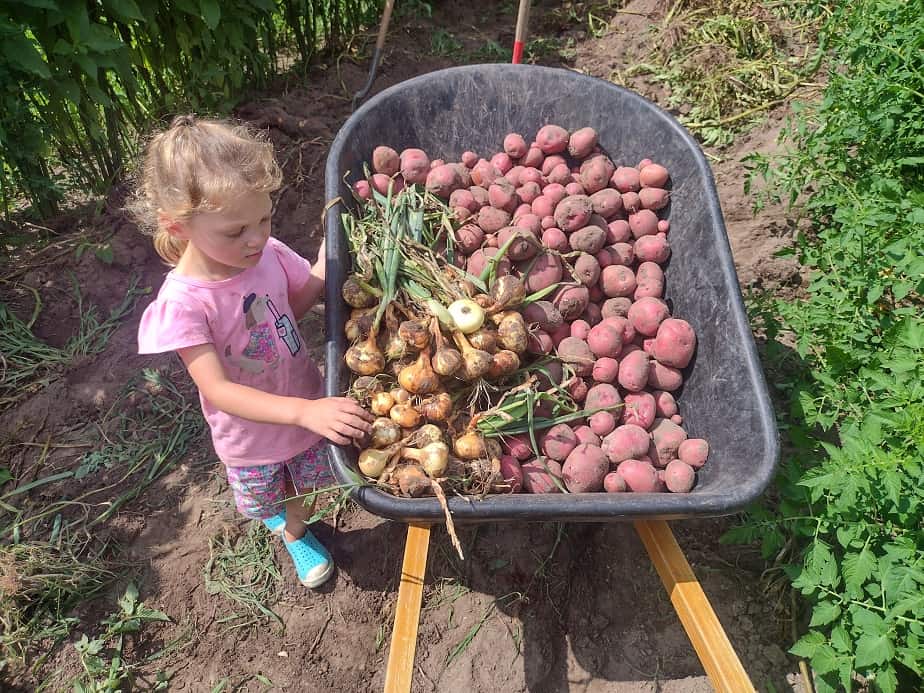Onions have become one of the staple crops for our small farm.
To grow good onions in Michigan, you need soft soil, full sun, and high fertility. Onions need a lot of water, and are easily impacted by weed pressure. Onion sets, seeds, or transplants can be planted in April, or when the soil starts to thaw in spring. The tastiest onions are grown in rich, deep topsoil.
Weather a small garden or several acres, these tips will help your harvest.
Growing Great Onions in Michigan
There are three types of onion that can be harvested, Green onion, scallions, and big bubbled onions. The only real difference is the size of the plant. Green onions are basically any onion harvested in the early growth stage, before any sign of bulb formation has begun.
Some varieties won’t bulb much and only make good green onions. For larger varieties, they are just harvested quite young and small for a good green onion. Green onions are usually picked when they are a bit fatter than a pencil.
Scallions are slightly larger onions, usually between an inch and half-inch in diameter at the bulb. Some varieties are more of a true scallion, maxing out at that size. That’s like the Egyptian Walking Onion, it’s a great scallion, or green onion if picked a bit earlier.
Large bulb onions range from two to five inches in diameter. They take longer to get that size, and need really good fertility and soil moisture. They are also very much daylight sensitive. You need the right variety for your growing season’s day-length. I’ll get more into that in a minute.
Large bulb varieties can be picked early at either the green onion or scallion stage. It’s this variety that’s both the most popular and the trickiest to grow well. Anytime you want things big, it’s a fussy procedure.
The big unique point about onions is that they have very meager, quite fragile foliage. That’s where a lot of the hardship in growing inions comes from. Since they don’t have much green foliage to conduct photosynthesis, a little shade from weeds will significantly impact them.
Onions are super sensitive to weed pressure because of that. Most other garden plants will eventually block out a lot of weeds, but onions will not. Onions need more regular weeding than anything else I grow. Onions will never form good bulbs when they is significant weeds.
You have to be very careful while weeding because the foliage is fragile and can snap over. That often means the onion will not grow well. it really stunts the plant when the top has bent over. It gets a tight crease that restricts the flow of plat sap and nutrients.
Because onions don’t shade the soil much, High quality soil is must for onions. Soil that is high in organic matter, or at least has a good topsoil, will hold moisture in the soil. Mulching is also very useful with onions, it really evens out the soil moisture to a more constant state.
Onions need irrigation to grow well and reach a big size. I used impact sprinklers mounted on t-posts for my 1/4 acre onion stand this year. A simple setup works, just don’t let the soil get dry more than about an inch down. When it’s bone dry 2-inches deep, onion roots start dying off.

How to Plant Onions
Onions are often planted from sets in northern states. That is, small onions that were grown the previous fall. Sets may be just a bulb or may have a green stalk. Planting from sets will save you three months or more of growing time. Onions can be planted from seed, but it’s hard to get as big of a bulb that way.
Sets can be efficiently planted by hand as soon as the soil has thawed out for good in the spring. That’s usually around late April. They need to be planted as early as possible to give them the most growing time before they start to bulb. I plant them an inch deep and 4-inches apart.
Seeds are best sown indoors in trays 3 months before the desired planting date. I’d start seeds right after Christmas. I’d recommend planting them in 2-inch deep trays. spread seeds heavily in the soil and lightly work them in with your fingers. Water, cover with plastic wrap, and keep between 55 and 70 degrees.
Warmer is better. You can set them in a grow light or on a windowsill if if gets good light and isn’t too cold. They absolutely need decent light. When they sprout, uncover and keep them evenly moist. You will be growing a mat of onion babies.
A lot of experts recommending trimming the tops with scissors once a month to keep them about 6 to 9 inches tall. That’s supposed to grow a stronger base. Come April or May, whenever the soil is thawed and not too waterlogged, plant them an inch deep and 4-inches apart.
Planting onions too deep restricts the size of the bub later. The bulb should form mostly above the soil so it has space to swell easily.

How to Grow Big Onions
To get big onions you need high fertility, lots of water, and loose soil. They also need full sun, no weeds, and to be planted fairly shallow. Perhaps the most important part of growing huge onions is getting the right daylength variety. Onions come in short day, mid day, and long day varieties.
In the north, we have long summer days, getting up to 15 hours of daylight. Going south, the daylight hours get shorter. Onion bulbing is very light sensitive and is triggered by a specific amount of daylight.
Short-day onions will start bulbing when there’s about 10 or 12 hours of daylight. Long day onions are triggered into bulbing when the daylight is about 14 hours long. If you plant a short day onion in Michigan, it will start bulbing way too early when the plant is still small. It will make small bulbs.
In Michigan, we need long-day varieties to get big bulbs. The most common is the Spanish yellow onion. There are red and white varieties that will do as well. Just make sure that you’re buying a long-day variety.
Besides that, you need a high fertility soil with excess nitrogen to get big onions. That’s one part most home gardeners miss.
How to Fertilize Onions
Onions are fertilized with a high nitrogen, high potassium fertilizer at an NPK ratio of about 2-1-2. Onions need a high dose of nitrogen up until the summer solstice, when the daylight triggers bulbs to form. Then they need more potassium to bulk up.
An even fertilizer like 10-10-10 is not good for onions, but if you must use it, it’s wise to add extra nitrogen to it. I fertilize large onions just like I do for corn. Smaller onions don’t need quite as much.
Approximate fertilizer for onions
This chart shows the amount of N-P-K (nitrogen-phosphorus, and potassium) that is commonly needed for onions (approximated).
| Acre N-P-K in pounds | 1000 square feet N-P-K in pounds | 100 square feet N-P-K in ounces | |
| Green onions | 70-35-50 | 1.75-0.75-1.25 | 3-2-2 |
| Scallions | 100-50-80 | 2.25-1-2 | 4-1.5-3 |
| Medium bulb onions | 160-80-130 | 3.75-2-3 | 06-3-5 |
| Large bulb onions | 200-80-140 | 4.5-1.75- 3.25 | 7-3-5 |
Other minerals that are often added, but at a very low level, are boron and zinc. A fertile, dark topsoil should have plenty of those two of those micronutrients. The best soil you can get for most things is a soil a sandy base and lots of dark organic matter.
Because onions are planted quite early, fertilizer is often applied in two or three applications. You can start with an even numbered fertilizer, at planting, then apply some heavy nitrogen one month, then two months later. Soil testing is important to see just what your garden is actually doing fertlity wise.
You may already have half the fertility you need. A DIY soil test showing a high fertility means you don’t need to add much of anything. A middle-range result would be fine for small onions, but would only be about half of what’s needed for larger onions.

Intercropping with Onions
Onions can be effectively intercropped with other plants to improve the soil biodiversity and to help repel pests from other plants. The issue is that onions are easily overcrowded. I intercrop a lot with onions but that tends to result in smaller onions because most plants will overshadow an onion.
This year, I planted onions alongside potatoes, alternating rows. I tried spacing of both one and two feet between rows. in both cases, the onions were completely overgrown b the potatoes mid-season. That caused the onions to stress out and mature early.
The result was a ton of tiny onions, and the onions matured quite early. I did get a moderate onion harvest out if it and it did help with potato bugs a bit.
If intercropping or such, just remember that onions need some space and most garden plants will end up either overshadowing or crushing down the onion stalks.
Related Articles:

